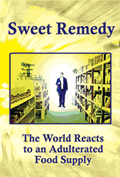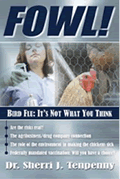REASONS TO JUST SAY NO TO VACCINES
Dr. Sherri Tenpenny, DO
July 9, 2008
NewsWithViews.com
Vaccinating children has become sacrosanct in our culture. Doctors and government officials insist that vaccines are safe, and parents are pressured into compliance. In fact, parents have been reported to social services by doctors who consider not vaccinating to be a form of medical neglect or child abuse. Legislators across the country are attempting to pass laws in which parents will have no rights to refuse what is injected into their children.
The inconsistency of rules involving the care of children is striking. Mothers are in complete control of their child’s health while in the womb. They make choices against eating tuna, taking medications, smoking cigarettes and avoiding alcohol. Mothers may choose to even terminate the pregnancy. But the moment the baby arrives, control over their child’s body is forcibly surrendered to healthcare providers and the government. The leg is jabbed with shots, eyes are gooped with antibiotic ointment and the heel is poked to get a drop of DNA-containing blood. With the passage of the Newborn Screening Saves Lives Act of 2007, signed into law April 24, 2008, the blood will be collected and warehoused for scientific research.[1] Parents have little or no say in any of these events. (see my previous article, “Who Owns Your Child?”)
Vaccination is promoted by an industry that capitalizes on fear and the perceived necessity of the procedure has become multi-generationally entrenched. We have been programmed by the medical community and the media to believe that everyone – children and adults -- will become sick, and likely die, unless they are vaccinated. This explains why not vaccinating can be unfathomable to new parents who are unreasonably terrified of what were considered normal childhood illnesses only a few decades ago. The majority adults over 50 years of age remember having measles and the chickenpox. Both were mostly mild diseases, lasting seven to fourteen days, and leaving behind lifetime immunity.
And even though chickenpox is rarely fatal, most parents opt to vaccinate. Merck & Co. estimated that as of December 31, 2007, 80 to 85 percent of all four to six-year-olds had received two doses of Varivax®, at one year and a booster before school.[2] With little attention on the problems with the chickenpox vaccine cited in the media, most don’t realize that it can cause harm. Research shows that nearly 1 in 5,000 children who receive the chickenpox inoculation develop shingles within ten years of being vaccinated. Shingles, an intensely painful, blistering rash, is most commonly seen in the elderly or the chronically ill. It was rarely, if ever, seen in healthy children before the introduction of this vaccine. Other serious side effects, such as seizures, pneumonia, and anaphylaxis (a severe allergic reaction), have been reported as a result of Varivax. Before it became available, about 50 children died every year from rare or unusual complications of the chickenpox. Put in perspective, 53 children died in drowning accidents in the [U.S.] state of Georgia in 1999.
Vaccination has been cited as one of the ten greatest public health achievements of the 20th century. However, it doesn’t require an advanced degree in science to grasp that the public health accolades, celebrating high vaccination rates and low infection rates, have lead to serious health consequences across the globe. Vaccine ingredients seem to be playing a substantial role.
Problems With Vaccine Ingredients
Gelatin, one of many ingredients in vaccines, is known to cause allergies and asthma. Allergies are now the most frequently reported chronic condition in children, limiting activities in four out of 10 children. Asthma, the second most common chronic childhood disease, affects more than one child in 20. The combined healthcare costs of asthma and allergies have soared to more than $25 billion/year.[3] Vaccines that contain gelatin include chickenpox, MMR, Boostrix (teen pertussis booster), Tripedia (DTaP) and the adult shingles vaccine, Zostrix. Vaccine gelatin may be contributing substantially to the skyrocketing incidence of, and expenditures on, asthma and allergies.
Another vaccine additive, formaldehyde, can interrupt the normal function of the immune system. A colorless, pungent-smelling gas, formaldehyde can cause watery eyes, burning sensations in the eyes and throat, nausea, difficulty in breathing and asthma attacks when exposed to amounts as small as 0.1 parts per million. It is listed as a hazardous chemical on eight federal regulatory lists and considered to be one of the ten worst compounds on the ecosystem and health. Between 10 and 20 percent of general population has a reaction coming in contact with formaldehyde. Topical exposure can cause a mild reaction, such as dry skin and redness. The California Indoor Air Quality Fact Sheet states there is no known threshold level below which cancer risk does not exist.[4] The World Health Association (WHO) recommends that an exposure should not exceed 0.05 ppm or 0.05 mg/kg. So, for 12 pound baby (about 5kg), the maximum exposure should be below 0.25 mg. But with the current schedule, children receive more than ten times that amount, more than 3.5 mg, if they receive every mandated vaccine. Vaccines that contain formaldehyde include DTaP, polio, influenza, hepatitis A and hepatitis B.
Thankfully, mercury (in the form of thimerosal) has been removed from most vaccines. However, measurable amounts are still found in multi-vial flu shots, tetanus boosters, Energix-B (hepatitis B vaccine), Menomune (college meningitis vaccine), TriHiBit and Tripedia (both DTaP vaccines), and Twinrix (a combination hepatitis A and hepatitis B vaccine). Trace amounts remain in many more. Countless children have developed autism and there is strong evidence that their brains were injured by the preservative thimerosal.
Follow the Money
Positioned as a loss leader, vaccines appear to be the economic drivers of both the medical and the pharmaceutical industry. A loss leader is a business technique in which a less-expensive product is sold or given away for the sake of offering another product at a greater profit. This common practice is utilized to introduce new customers to a product, to build a new customer base and/or to secure future recurring revenue. Using a loss leader is more than just a nifty business trick - it can be a very successful economic strategy when executed properly. The classic example of a loss leader is the sale of razor blades. Companies like Gillette essentially give their razor units away for free, knowing that customers will buy their replacement blades, where the company makes all of its profit, for as long as they use the razor.
Vaccines play a similar role for the drug companies. The cost of a vaccine is relatively inexpensive compared to the billions of dollars spent on medical interventions, medications—and even more vaccines—dispensed as a result of a vaccination side effect.
Consider this example: the potential consequences of an inoculation with one of the two newly approved vaccines to prevent a rotavirus diarrheal infection, RotaTeq® and Rotarix®.
Side effects listed on the package insert for RotaTeq include diarrhea, vomiting, irritability, fever, wheezing and coughing. RotaTeq has also been associated with bloody stools, a warning sign of a serious complication called an intussusception. Triggered by the vaccine, intussusception is an event where a portion of the bowel slides into the next, much like the pieces of a telescope, causing an obstruction. Swelling, inflammation, and decreased blood flow to the fragile lining of the bowel cause the intestine to die. Between February 3, 2006, when RotaTeq was licensed, and January 31, 2007, twenty-eight cases of intussusception were reported in infants who received RotaTeq in the U.S. Sixteen of the 28 infants required hospitalization and surgery on their intestine.
In February, 2008, the FDA issued a warning that there was a "statistically signficant increase in pneumonia-related deaths and seizures" associated with the other vaccine for rotavirus infection.[5] To reduce the risk of pneumonia, doctors promote the pneumococcal vaccine, Prevnar®. A side effect of Prevnar, as listed in the package insert, is ear infections, increasing the use of antibiotics. The many rounds of antibiotics required to treat recurring ear infections can cause serious bowel problems, leading to blood tests and evaluations by the pediatric gastroenterologist. The cause of all these additional problems is rarely indentified as a side effect of a vaccination.
All
of this can result from a Rotarix or a RotaTeq shot, given to avoid
a common infection that most children contract, and recover from uneventfully,
by the time they are three years of age.
Another example is the hepatitis B vaccine, given at birth, can cause
diarrhea, vomiting, and dyspepsia (a condition associated with gnawing
or burning stomach pain and persistent vomiting). Tiny children receive
x-rays, undergo procedures such as endoscopy, and are given adult
medications such as Prilosec® or Nexium® to resolve their
discomfort. Unfortunately, since the dyspepsia is not recognized as
a vaccine side effect, additional dosages of the hepatitis B vaccine
are administered, often compounding the problem.
Vaccines are the bedrock of expanded illnesses, skyrocketing medical costs and exponential drug sales. But it is more than individual vaccines that are cause for concern. The sheer number of vaccines children now receive between birth and six years of age is staggering and include: Diphtheria (a rare throat infection), pertussis, and tetanus (the DTaP shot); Haemophilus influenza type b (the Hib vaccine); measles, mumps, and rubella (the MMR shot); pneumococcus (the Prevnar vaccine); polio (three strains); rotavirus (five strains); and individual vaccines for hepatitis A, hepatitis B, chickenpox, and meningitis. Flu shots (three strains) are now given annually, beginning at six months of age. That adds up to 113 vaccine antigens by kindergarten given in about 33 shots.
Parents are becoming wary of the many needles being jabbed into their precious babies at the tender age of two, four and six months. In response, the drug companies are combining several vaccines into a single injection. Comvax (hepatitis B and HiB), ProQuad (MMR and chickenpox), Pediarix (DTaP, polio and hepatitis B) and two newly approved vaccines, Kinrix (DTaP and polio) and Pentacel (DTaP, polio and HiB) have been developed. Parents are deceived into believing that the combination shots are fewer vaccines; they are not: The number of jabs is reduced, but the number of antigen doses remains the same.
A significant problem with the combo shots is that, in the event of an adverse reaction, there is no way to determine which component caused the problem. This eliminates the ability to refuse additional doses of a particular vaccine. The ability to make a claim with the Vaccine Injury Compensation program is likewise negated.
For adults who believe the days of deciding about vaccines are over because their children are now teenagers, think again: Teenagers are the new target market for the vaccine industry. Boosters are being recommended for vaccines given before five years of age and the new teen vaccines, Gardasil (for cervical cancer) and Menactra (for college-type meningitis), are being heavily marketed by doctors and the media. The additional vaccines add substantially to the total number of vaccine antigen. If little girls receive all doses of all recommended vaccines, they will have received 156 vaccine antigens and about 45 shots by middle school. Boys, not yet approved for Gardasil, receive slightly fewer: only 144 vaccine antigens and about 42 shots.
Many more vaccines in the pipeline will put teens and adults in the industry crosshairs. In 2007, adult-teen vaccine sales overtook pediatric sales, the first time ever, accounting for 50.6% of all revenues. This development has been attributed to robust sales of influenza vaccines and the success of Merck’s advertising to promote Gardasil for the HPV virus. Gardasil alone posted $1.5 billion in sales in 2007.[6]
And yes, it’s about the money. In addition to driving revenues as a loss leader, the newer vaccines are driving revenues through direct sales of expensive vaccines. According to Genetic Engineering & Biotechnology News,[7]















